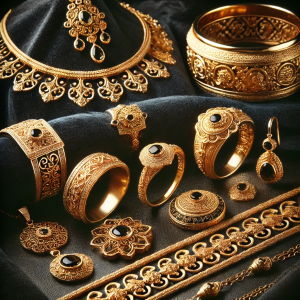Jewellery: A Timeless Expression of Art, Culture, and Identity

Jewellery is an integral part of human culture, transcending time, geography, and social boundaries. From ancient civilizations to modern fashion, jewellery has always held a special place in human society. It serves as a symbol of wealth, status, love, and personal expression, while also reflecting cultural heritage and artistry.
The History of Jewellery
 Jewellery has been worn by humans for thousands of years, dating back to ancient times. Early forms of jewellery were made from materials like shells, bones, and stones, often used as amulets for protection or to signify social status. As human craftsmanship evolved, so did jewellery, with civilizations like the Egyptians, Greeks, and Romans crafting intricate designs from precious metals and gemstones.
Jewellery has been worn by humans for thousands of years, dating back to ancient times. Early forms of jewellery were made from materials like shells, bones, and stones, often used as amulets for protection or to signify social status. As human craftsmanship evolved, so did jewellery, with civilizations like the Egyptians, Greeks, and Romans crafting intricate designs from precious metals and gemstones.
In ancient Egypt, jewellery was not only worn for adornment but also as a symbol of religious and cultural significance. Gold, considered the flesh of the gods, was used extensively to create intricate necklaces, bracelets, and earrings adorned with precious stones like turquoise, lapis lazuli, and carnelian.
A Gleaming Ring on Silk with Shimmering Bokeh Lights.
 Greek and Roman jewellery, on the other hand, was heavily influenced by mythology and art. Jewellery during this period often featured motifs of gods, animals, and symbols associated with luck or protection. The Romans, in particular, popularized the use of signet rings, which were engraved with personal seals and used to authenticate documents.
Greek and Roman jewellery, on the other hand, was heavily influenced by mythology and art. Jewellery during this period often featured motifs of gods, animals, and symbols associated with luck or protection. The Romans, in particular, popularized the use of signet rings, which were engraved with personal seals and used to authenticate documents.
During the Middle Ages, jewellery became an emblem of power and status. Royal families and the wealthy elite would wear elaborate pieces made from gold, silver, and gemstones to signify their importance in society. The Renaissance period brought a revival of art and creativity, and this was reflected in the intricate and ornate designs of jewellery, often inspired by nature, mythology, and religious themes.
Types of Jewellery
 Jewellery comes in a wide variety of forms, each serving different purposes and catering to various tastes and styles. Some of the most common types of jewellery include:
Jewellery comes in a wide variety of forms, each serving different purposes and catering to various tastes and styles. Some of the most common types of jewellery include:
- Rings
Rings are one of the most popular and symbolic types of jewellery. They have been used throughout history to represent everything from marriage (wedding rings) and authority (signet rings) to personal milestones (birthstone rings) and fashion. Rings can be made from various materials, including gold, silver, platinum, and a wide range of gemstones.
- Necklaces
Necklaces are worn around the neck and have been a staple of adornment since ancient times. They come in many styles, including pendants, chokers, and chains. The design and length of necklaces can vary, with some serving as simple fashion statements and others signifying religious or cultural identity.
- Bracelets
Bracelets, worn around the wrist, have been worn by men and women for centuries. They can be made of metals, beads, leather, or fabric, and may include charms, gemstones, or personalized elements. In many cultures, bracelets are worn as symbols of protection, friendship, or love.
- Earrings
Earrings are worn on the ears and come in numerous styles, such as studs, hoops, and dangles. In many societies, earrings are considered a sign of femininity, though they are also worn by men in various cultures.
- Brooches and Pins
Brooches and pins are decorative pieces that can be worn on clothing. In earlier times, they were used primarily for fastening garments, but today they are worn as stylish accessories.
- Anklets
Anklets are worn around the ankle and have cultural significance in regions such as South Asia, where they are often associated with marriage and femininity. In modern times, anklets have become popular fashion accessories around the world.
Jewellery as a Symbol of Love and Commitment
One of the most significant uses of jewellery is in the realm of love and commitment. Engagement rings and wedding bands are perhaps the most well-known examples of jewellery used to symbolize romantic bonds. The tradition of giving a diamond engagement ring became popular in the late 19th century and has since become a universal symbol of commitment.
In addition to romantic symbolism, jewellery can also represent other types of meaningful relationships. Friendship bracelets, family heirlooms, and personalized pieces like birthstone necklaces or charm bracelets allow individuals to carry tokens of their loved ones with them.
Materials Used in Jewellery
Jewellery is made from a wide array of materials, ranging from the most precious metals and gemstones to more affordable alternatives. Some common materials used in jewellery include:
- Precious Metals
Gold, silver, and platinum are the most commonly used precious metals in fine jewellery. Each metal has its own unique properties and significance. Gold, for example, has long been associated with wealth and immortality, while silver is often linked to purity and wisdom.
- Gemstones
Diamonds, rubies, sapphires, and emeralds are among the most sought-after gemstones, prized for their beauty, rarity, and durability. Gemstones are often selected based on personal preferences, astrological beliefs, or birthstones, adding another layer of meaning to the jewellery.
- Organic Materials
In addition to metals and stones, some types of jewellery incorporate organic materials like pearls, coral, and ivory. These materials have been used in jewellery for centuries, offering a natural elegance to the pieces they adorn.
- Synthetic Materials
Modern jewellery often includes synthetic or lab-created gemstones, which provide a more affordable alternative to natural stones. These materials mimic the appearance of their natural counterparts and are increasingly popular for their ethical and environmental benefits.
The Role of Jewellery in Modern Fashion
In the contemporary world, jewellery plays a crucial role in personal style and fashion. It is no longer just a marker of wealth or status but also an essential accessory for self-expression. Designers continually push the boundaries of creativity, experimenting with new materials, shapes, and trends. From minimalistic designs to bold, statement pieces, jewellery is as diverse as the people who wear it.
Celebrities and influencers play a significant role in setting jewellery trends, with red-carpet appearances and social media platforms showcasing the latest designs. Custom-made and artisanal pieces are also gaining popularity as more people seek unique items that reflect their individuality.
Conclusion
Jewellery is far more than just a decorative accessory; it is a form of personal and cultural expression with deep historical roots. Whether passed down as a family heirloom, given as a symbol of love, or worn to make a fashion statement, jewellery continues to captivate and inspire. Its timeless appeal lies in its ability to blend art, tradition, and innovation, making it a cherished and meaningful part of human life.
